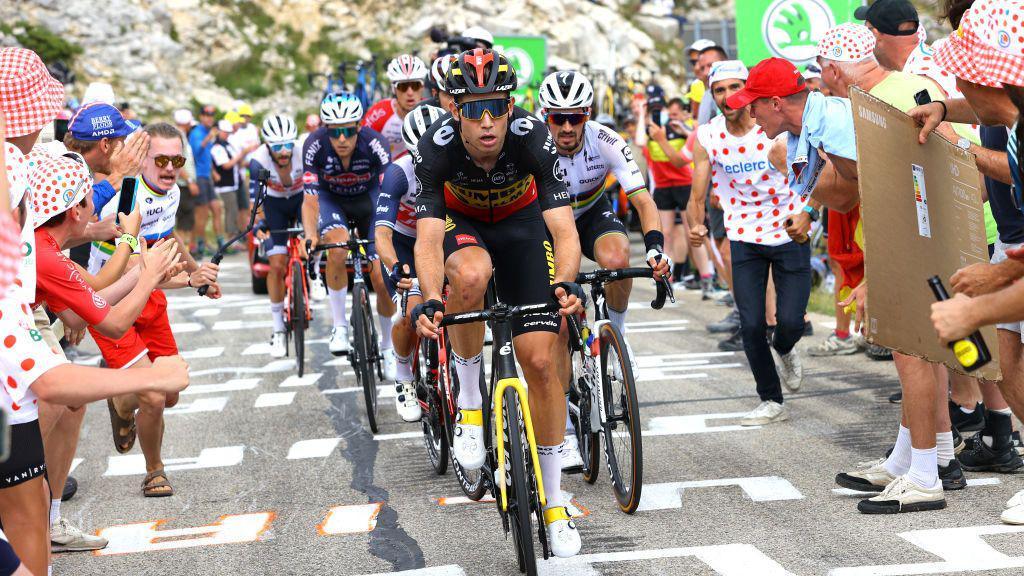How dangerous is the Tour de France?
- Published
A key factor in being successful in the Tour de France is staving off dangers that crop up during the 3,320km race.
With 21 stages across a 23-day period, the 2,075-mile course poses a range of challenges and terrains for the 184 riders battling it out for the yellow jersey.
Just seven of the 21 stages of the Tour are deemed flat, with the rest a mixture of hilly and mountainous stages, as well two time trials.
From sprint finishes that can end in crashes to treacherous mountain climbs and collisions with spectators, the 112 editions of the Tour de France have thrown up their fair share of trouble for riders.
Get in touch
Send us your questions
What makes the Tour de France so dangerous?

Spectators often line the roads in close proximity to the riders
Riders can reach speeds of up to 80mph during faster stages of the Tour, which allows very little margin for error in a peloton that often rides closely together.
As a result, corners and sprint chases can often lead to incidents.
The tests posted by steep climbs during the mountain stages and the speed of descents also lead to increased risk of accidents and injury.
Other risks included the required endurance across the 21 stages, weather conditions, mechanical faults and incidents caused by spectators viewing in close proximity to the riders.
Who are the four people to have died during a Tour?
In the 2025 Tour alone, there have been a number of serious crashes and incidents that have forced riders to withdraw.
Emilien Jeanniere abandoned during the fifth stage after fracturing a shoulder, while Joao Almeida left the race on stage nine after a crash two days earlier that involved a number of other riders.
And on Thursday, the dangers of cycle racing were underlined when the Tour riders paused for a moment of silence at the start line following the death of 19-year-old Italian rider Samuele Privitera in a crash during the first stage of the Giro della Valle d'Aosta.
There have been four fatalities in the history of the Tour.
The most recent was Italy's Fabio Casartelli, who in 1995 crashed while descending the Col de Portet d'Aspet.
The first was in 1910, when teenager Adolphe Heliere died during the race. The cause of his death is unclear but after he slept on the beach following a stage, doctors rescued him out of the sea, though were unable to save his life.
In 1935, Francisco Cepeda died after crashing into a ravine while coming down the Col du Galibier.
Britain's Tommy Simpson was the third racer to die during a Tour de France.
A world champion in 1965, Simpson suffered multiple crashes while riding up Mont Ventoux in hot weather.
He initially fell unconscious and was later pronounced dead at hospital.
An autopsy founded traces of amphetamines in his body, though the official cause of his death was given as a heart attack.
The 2025 Tour will go up Mont Ventoux, where a memorial remains for Simpson, on stage 16.
A cardboard sign and a €1,200 fine
There have also been crashes caused by keen spectators.
In 2021, a Frenchwoman was fined 1,200 euros (then £1,028) for causing a crash by waving a cardboard sign in the path of the riders.
The woman was holding a sign with the German named for "granny and granddad" but did not see the peloton approach.
The sign clipped German rider Tony Martin, which caused him to fall and dozens of other riders to crash into him.
As a result of the crash, two riders had to pull out the Tour and eight others were treated for injuries.
When did helmets become compulsory?
The International Cycling Union made it mandatory to wear helmets at the Tour de France and all other endorsed races in 2003.
Drivers had to wear helmets for the duration of the race, except the final climbs.
Then in 2005, the ruling changed to ensure helmets were worn by riders at all times during the race.
Prior to this, it was not mandatory for riders to wear helmets, instead it was left to the individual rider and their preferences.
The ruling was brought in after the death of Kazakh rider Andrey Kivilev in 2003. He died after sustaining a head injury from a collision at the Paris-Nice race.
The 2003 Giro d'Italia was the first race where it was mandatory to wear a helmet.
Thank you to Robbie in Newcastle for your question.
This article is the latest from BBC Sport's Ask Me Anything team.
What is Ask Me Anything?
Ask Me Anything is a service dedicated to answering your questions.
We want to reward your time by telling you things you do not know and reminding you of things you do.
The team will find out everything you need to know and be able to call upon a network of contacts including our experts and pundits.
We will be answering your questions from the heart of the BBC Sport newsroom, and going behind the scenes at some of the world's biggest sporting events.
Our coverage will span the BBC Sport website, app, social media and YouTube accounts, plus BBC TV and radio.